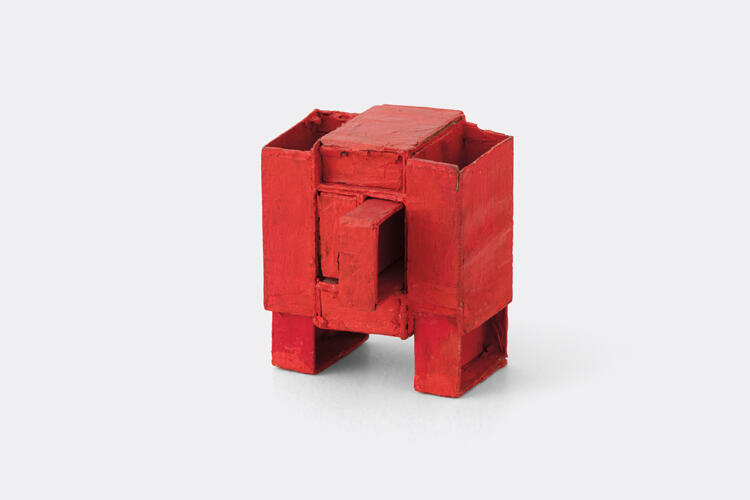The Brilliant Orbit of Clarice Lispector
At Instituto Moreira Salles, the writer anchors an exploration of Brazilian women’s art and literature in the mid- to late-20th century
At Instituto Moreira Salles, the writer anchors an exploration of Brazilian women’s art and literature in the mid- to late-20th century

‘Everything in the world began with a yes’, Clarice Lispector, who was born in the Ukrainian People’s Republic in 1920 and died in Brazil in 1977, wrote in The Hour of the Star (1977). This quote opens ‘Constelação Clarice’, an exhibition of the work of the writer and her contemporaries curated by Veronica Stigger and Eucanaã Ferraz. The show is less about Lispector – who looms large in the world of Brazilian letters – than it is an effort to deploy the author as a point of departure for broader reflections on the intersections of art and literature by Brazilian women in the mid- to late-20th century.

Some of the visual artists featured in the exhibition were Lispector’s friends, such as the Italian-born painter and sculptor Maria Bonomi, whose colourful abstract works she collected. Others, such as the painter and illustrator Djanira, she profiled as a columnist for the popular Brazilian magazine Manchete. Claudia Andujar offers a tryptic of enlarged negatives of a female torso (From the series ‘A Sônia’, 1971), as well as striking portraits of Lispector.

But it is in the spaces of no explicit connection that Stigger and Ferraz have gone to work, stitching together narratives of isolation, striving and dislocation across the disparate practices of nearly 30 artists, conjuring a constellation of ‘possible dialogues’ (Lispector’s column in Manchete was titled ‘Possible and Impossible Dialogues’). Quotations from her many novels encapsulate themes that frame an impressive array of paintings, sculptures, drawings, recordings and video art that speak to one another. For example, constructivist Lygia Clark’s miniature geometric sculptures (Estrutura de caixas de fósforos, ‘Structure of matchboxes’, 1964), whose rugged formalism evokes a bristling frustration, converse with poet Hilda Hilst’s audio recordings of untuned radio frequencies (Hilda Hilst pede contato, ‘Hilda Hilst requests contact’, undated), suggesting the possibility of a language we are still unequipped to understand.

Symbols that invoke origins, rebirth and reproduction populate the first gallery, with Celeida Tostes’s ceramic egg sculptures, tucked into nests and industrial-sized cartons (Ninhos, ‘Nests’, undated), buttressed by a Lispector quote: ‘How to start from the beginning, if things happen before actually happening?’ The challenges of being a woman artist permeate the show, though the curators manage to approach this theme with nuance: it is made clear that the effervescence of some of the works is tethered to a reluctant allegiance to or subversion of the roles assigned to women of Lispector’s milieu: mother, wife, hostess, helpmeet. Lispector herself was the wife of a diplomat, whose assignments obligated his family to relocate multiple times during their loveless marriage. Performance artist Letícia Parente’s work intuitively accesses this compulsory domesticity: Eu, armário de mim (‘I, Closet of Myself’, 1975), a short video, depicts rotating images of the interior of a wardrobe, filled at first with common household objects but later home to a parade of unexpected items: crumpled paper, an X-ray of a ribcage. In In (1975), Parente suspends herself on a clothes hanger, closing the doors of the wardrobe as if to pre-empt the foreclosure of her own ambitions.

Later in her life, Lispector turned to painting (without professional aspirations, the show’s curators make clear). Her rarely displayed works in acrylic and oil paint are crude and small, yet dynamic. They seem to be propelled by a powerful drive to create, the same creative tenacity that led Lispector to produce countless works of fiction and non-fiction. This impression is heightened in similarly visceral works such as Maria Martins’s softly human bronze sculpture (Anunciação, ‘Annunciation’, 1952), and photographs of bodily surfaces pressed against a camera lens from Vera Chaves Barcellos’ series ‘Epidermic Scapes’ (1977), which hang nearby. As Lispector wrote, also in The Hour of the Star, ‘I am not an intellectual, I write with my body.’
‘Constelação Clarice’ is on view at Instituto Moreira Salles, Rio de Janeiro, until 9 October.
Main image: Clarice Lispector, Explosão [Explosion], 1975, acrylic and nail polish on wood, 37.5 × 50 cm. Courtesy: Clarice Lispector Collection / Casa de Rui Barbosa Foundation, Rio de Janeiro; photograph: Vicente de Mello























